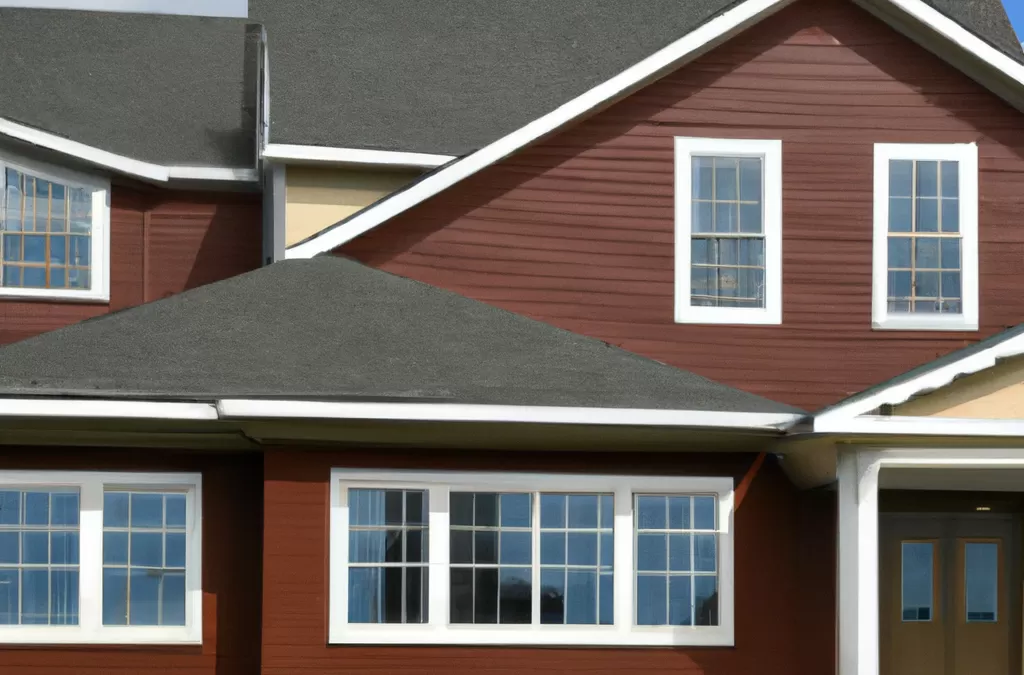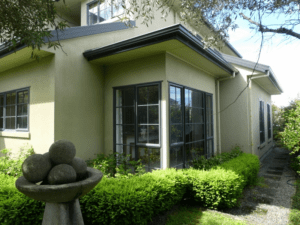
Image Source: Unsplash
## Introduction: Exploring the Wisdom of Painting Your House in Dark Colors
When it comes to painting our homes, we often find ourselves faced with a multitude of choices. One decision that can greatly impact the overall look and feel of our house is the color we choose. While lighter shades have long been popular, there has been a growing trend towards darker hues in recent years. However, before you take the plunge and paint your house a dark color, it is important to consider the potential issues that may arise. In this article, we will explore the wisdom of painting your house in dark colors and delve into various aspects such as heat absorption, fading concerns, visual impact, architectural style compatibility, climate considerations, neighborhood aesthetics, maintenance challenges, lighting effects, psychological impact, resale value, and expert recommendations.
Potential Issues Arising from Dark House Colors
While dark house colors can create a striking and dramatic look, they also come with their fair share of challenges. One of the primary concerns is heat absorption. Dark colors tend to absorb more heat from the sun, which can result in higher indoor temperatures. This can be particularly problematic in warmer climates, where it may lead to increased energy consumption for cooling purposes. Additionally, the excessive heat absorption can also cause the paint to expand and contract, leading to potential cracking and peeling over time.
Heat Absorption: Understanding the Impact of Dark Colors on Temperature Regulation
The heat absorption properties of dark colors can have a significant impact on the temperature regulation inside your home. Dark-colored exteriors absorb more heat from the sun’s rays, causing the surfaces to become hotter. This can result in higher indoor temperatures, especially during the summer months. As a result, your cooling system may have to work harder and consume more energy to maintain a comfortable temperature. This increased energy consumption not only affects your utility bills but also has a negative impact on the environment. It is important to consider these implications before deciding to paint your house a dark color.
Fading Concerns: Evaluating the Long-Term Durability of Dark Paints
Another factor to consider when contemplating painting your house a dark color is the long-term durability of the paint. Dark-colored paints are more prone to fading over time, especially when exposed to direct sunlight. The UV rays in sunlight can cause the pigments in the paint to break down, resulting in a dull and faded appearance. This can be particularly noticeable on dark-colored exteriors, as any fading becomes more apparent against the rich hue. Regular maintenance, such as repainting or applying a protective coating, may be necessary to preserve the vibrancy of the paint and prevent premature fading.
Visual Impact: Discussing the Aesthetic Effects of Dark House Colors
One of the most significant advantages of using dark colors on your house is the visual impact it can create. Dark-colored exteriors can add a sense of depth, elegance, and sophistication to your home’s overall aesthetic. They can create a striking contrast against the surrounding landscape and make a bold statement. Dark colors also have the ability to highlight architectural details and create a sense of drama. However, it is crucial to consider the architectural style of your home and how it will interact with the chosen dark color. Certain architectural styles lend themselves better to dark colors, while others may clash or appear out of place. It is important to strike a balance between personal preference and architectural harmony when selecting a dark color for your house.
Architectural Style Compatibility: Assessing the Suitability of Dark Colors for Different Home Designs
The architectural style of your home plays a crucial role in determining whether a dark color will be suitable. Some architectural styles, such as Victorian or Gothic, naturally lend themselves to darker hues and can enhance the overall aesthetic. On the other hand, more modern or minimalist designs may benefit from lighter shades that emphasize clean lines and simplicity. It is essential to consider the existing architectural elements, such as the roof, trim, and other exterior features, when selecting a dark color. Harmonizing these elements with the chosen color will ensure a cohesive and visually pleasing result.
Climate Considerations: Factoring in Environmental Conditions When Choosing Dark Paints
The climate in which you live should also be taken into account when deciding to paint your house a dark color. In hotter climates, dark-colored exteriors can absorb more heat, potentially increasing the indoor temperature and placing a greater demand on your cooling system. Conversely, in colder climates, dark colors can help absorb and retain heat, providing some energy-saving benefits during the winter months. It is essential to consider the environmental conditions and temperature fluctuations in your area to make an informed decision about using dark colors on your house.
Neighborhood Aesthetics: Considering Community Standards and Preferences
While your personal taste is important, it is also crucial to consider the aesthetics and preferences of your neighborhood. Some communities may have specific guidelines or restrictions on the colors that can be used for exterior house painting. It is essential to consult any homeowner association guidelines or local regulations to ensure compliance. Additionally, blending in with the surrounding homes can enhance the overall visual appeal of the neighborhood and potentially increase property values. While dark colors can make a bold statement, they may not always be the best choice if they disrupt the harmony of the community.
Maintenance Challenges: Addressing the Practicalities of Upkeep with Dark Paints
It is no secret that maintaining the appearance of your home requires regular upkeep. Dark-colored exteriors can pose additional challenges when it comes to maintenance. Dark paints tend to show dirt, dust, and other imperfections more prominently than lighter colors. This means that more frequent cleaning or power washing may be necessary to keep your house looking pristine. Additionally, touch-ups and repairs may be more noticeable on dark-colored surfaces, requiring extra attention to ensure a seamless finish. It is important to consider the potential maintenance challenges before committing to a dark color, especially if you prefer a low-maintenance exterior.
Lighting Effects: Examining How Natural and Artificial Light Interact with Dark House Colors
Lighting plays a crucial role in how colors appear, and this is particularly true for dark hues. Natural and artificial light can interact with dark house colors in various ways, creating different visual effects. In areas with ample natural light, dark colors can appear richer and more intense, showcasing their deep tones. On the other hand, in areas with limited natural light, dark colors can make the exterior look somber and gloomy. It is important to consider the lighting conditions around your home throughout the day and assess how the chosen dark color will be affected. Additionally, artificial lighting at night can dramatically alter the appearance of dark-colored exteriors, making them more or less prominent depending on the placement and intensity of the lights.
Psychological Impact: Reflecting on the Emotional Response to Dark Painted Homes
Colors have a profound impact on our emotions and can evoke different feelings and moods. Dark house colors can create a sense of mystery, drama, and sophistication. They can make a statement and leave a lasting impression. However, it is important to consider how the chosen dark color will affect the overall ambiance of your home. Dark colors can sometimes make a space feel smaller, more closed-in, or even oppressive. They may not be the best choice if you prefer a light and airy atmosphere. It is crucial to reflect on the psychological impact of dark painted homes and determine if it aligns with your desired emotional response.
Resale Value: Contemplating the Effect of Dark Colors on Property Marketability
When considering painting your house a dark color, it is essential to think about the potential impact on resale value. While dark colors can be visually striking and appealing to some buyers, they may not be universally appealing. Some potential buyers may have a preference for lighter, more neutral shades that offer a blank canvas for personalization. Additionally, dark colors can make a house stand out from the surrounding homes, which may not always be desirable if you plan to sell in the future. It is important to weigh the potential advantages and disadvantages of dark colors on property marketability and consider the preferences of potential buyers in your area.
Expert Recommendations: Insights from Design Professionals and Paint Specialists
To gain a well-rounded perspective on the wisdom of painting your house a dark color, it is valuable to consider the insights of design professionals and paint specialists. These experts have extensive experience and knowledge in the field and can provide valuable guidance based on your specific circumstances. They can help you select the right shade of dark color that complements your home’s architecture, takes into account the climate and lighting conditions, and meets any neighborhood guidelines or preferences. Consulting with experts can ensure that you make an informed decision and achieve the desired aesthetic and practical outcomes.
Conclusion: Weighing the Pros and Cons of Painting Your House a Dark Color
In conclusion, the decision to paint your house a dark color should be carefully considered, taking into account various factors such as heat absorption, fading concerns, visual impact, architectural style compatibility, climate considerations, neighborhood aesthetics, maintenance challenges, lighting effects, psychological impact, resale value, and expert recommendations. While dark colors can create a striking and dramatic look, they also come with potential drawbacks. By weighing the pros and cons, consulting with experts, and considering your specific circumstances and preferences, you can make an informed decision that enhances the overall appeal and value of your home.



